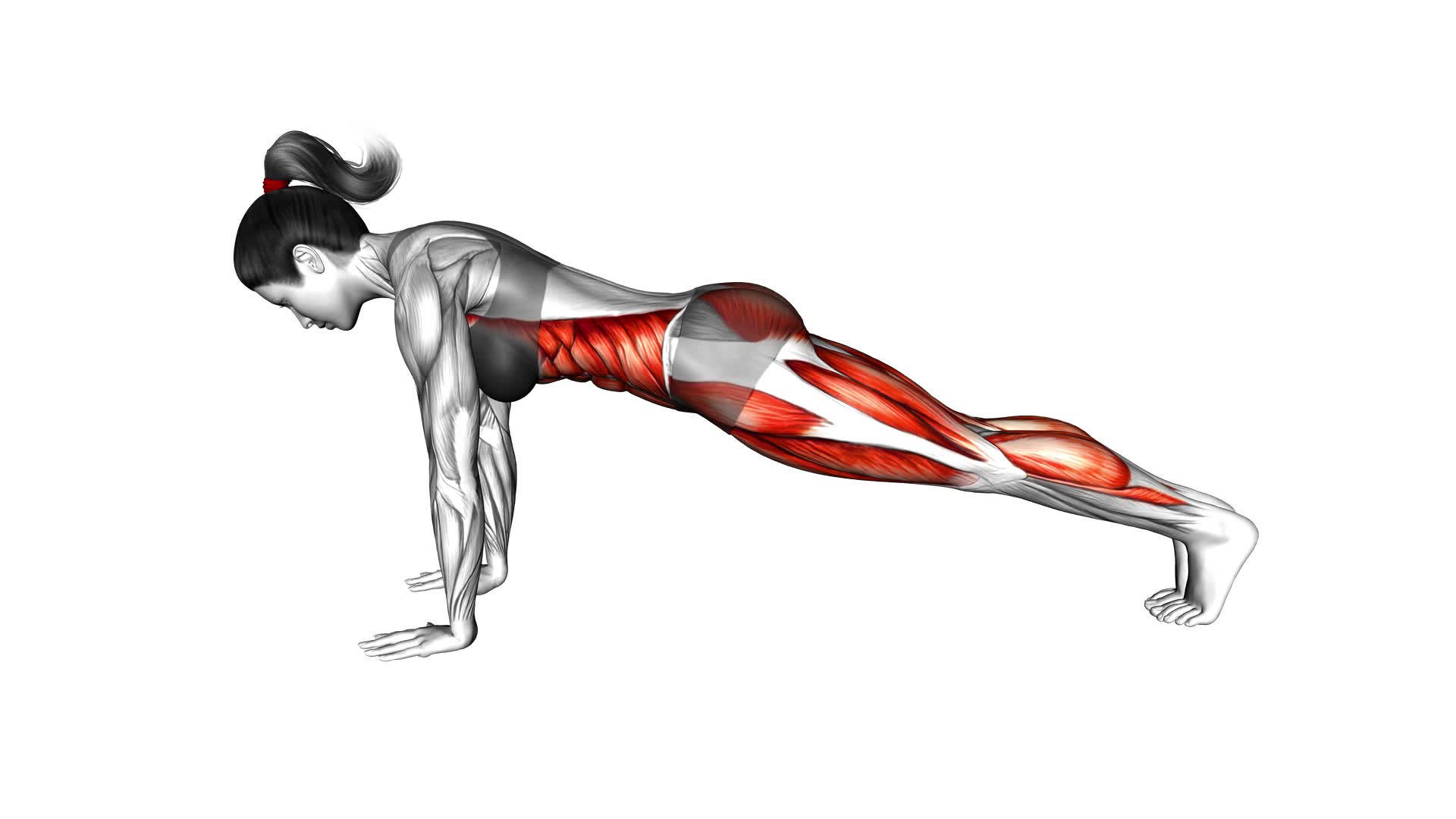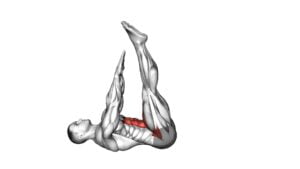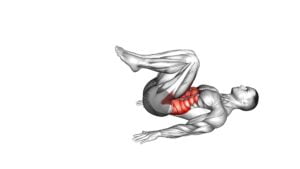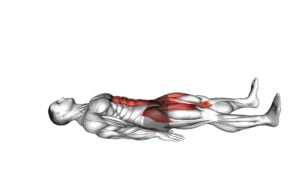High Plank Knee Drop (female) – Video Exercise Guide & Tips

Are you looking for an effective core exercise that targets your abs and obliques? Look no further than the high plank knee drop!
Watch This Exercise Video
In this video exercise guide, you'll learn the proper form and technique to perform this exercise correctly. We'll also cover common mistakes to avoid and provide modifications and progressions for all fitness levels.
Get ready to challenge your core and take your workout to the next level with the high plank knee drop. Let's get started!
Key Takeaways
- High Plank Knee Drop improves core strength and stability
- Proper form and technique are important for effective execution of the exercise
- Common mistakes include sagging hips, dropping the knee too low, and collapsing shoulders
- Modifications and progressions can be utilized to challenge different muscle groups and intensify the workout routine
Benefits of High Plank Knee Drop
You will experience numerous benefits from incorporating the High Plank Knee Drop into your exercise routine. This exercise is highly effective in improving core strength and increasing stability. When you perform the High Plank Knee Drop, you engage your core muscles, including the abdominals, obliques, and lower back. By continuously stabilizing your body in the plank position and then lowering one knee to the ground, you challenge your core muscles to work harder to maintain balance and control. This leads to improved core strength over time.
In addition to strengthening your core, the High Plank Knee Drop also helps to increase stability. As you lower one knee to the ground, you're required to stabilize your body and prevent any unnecessary movements. This helps to develop stability in your hips, shoulders, and spine. By incorporating this exercise into your routine, you can enhance your overall stability, which is essential for maintaining proper form in other exercises and daily activities.
Now that you understand the benefits of the High Plank Knee Drop, let's move on to discussing proper form and technique.
Proper Form and Technique
To achieve proper form and technique for the High Plank Knee Drop, it's crucial to focus on maintaining a stable and aligned position throughout the exercise. Here are some tips to help you perform this exercise correctly:
- Start in a high plank position with your hands directly under your shoulders and your body in a straight line from head to toe. Engage your core muscles by pulling your belly button towards your spine.
- Slowly lower one knee towards the ground, keeping your hips level and your back straight. Avoid any twisting or tilting of the pelvis.
- As you drop your knee, exhale and squeeze your core muscles to maintain stability. Pause for a moment in this position.
- Return to the starting position by lifting your knee back up and extending your leg fully. Inhale as you do so.
By focusing on maintaining a stable and aligned position, you won't only perform the High Plank Knee Drop safely but also effectively improve your core strength.
Common Mistakes to Avoid
To ensure proper execution of the High Plank Knee Drop and avoid common mistakes, focus on maintaining a stable and aligned position throughout the exercise. Proper technique is essential to maximize the benefits of this exercise and prevent injury.
One common mistake to avoid is allowing your hips to sag or lift too high, as this can put unnecessary strain on your lower back and decrease the effectiveness of the exercise. Instead, engage your core muscles and keep your hips in line with your shoulders and heels.
Another mistake to watch out for is dropping your knee too low or too quickly. This can cause excessive stress on your knee joints and compromise the stability of your plank position. Aim to lower your knee with control, maintaining a slow and controlled movement.
Lastly, avoid letting your shoulders collapse or round forward. Keep your shoulder blades engaged and your chest open to maintain proper alignment and prevent strain on your upper body.
Modifications and Progressions
To modify or progress the High Plank Knee Drop exercise, consider incorporating variations that challenge different muscle groups and add intensity to your workout routine. Here are some alternative exercises and advanced variations to try:
- Side Plank Knee Drop: Instead of dropping your knee towards the ground in a high plank position, start in a side plank position with your forearm on the ground. Then, lower your bottom knee towards the ground and lift it back up, engaging your obliques and core muscles.
- High Plank Mountain Climbers: Begin in a high plank position and instead of dropping your knee, quickly alternate bringing your knees towards your chest, as if you were climbing a mountain. This exercise targets your core, shoulders, and cardiovascular system.
- Plank Jacks: Start in a high plank position and instead of dropping your knee, jump both feet out wide and then back together, similar to a jumping jack motion. This exercise works your core, shoulders, and leg muscles.
- Spiderman Planks: Begin in a high plank position and instead of dropping your knee, bring one knee towards your elbow on the same side of your body. Alternate sides and engage your obliques and core muscles.
By incorporating these alternative exercises and advanced variations, you can challenge different muscle groups and take your workout routine to the next level.
Now, let's move on to the next section for tips on how to maximize the High Plank Knee Drop exercise.
Tips for Maximizing the Exercise
Maximize your High Plank Knee Drop exercise by focusing on proper form and engaging your core muscles throughout the movement. Here are some tips to help you get the most out of this exercise.
First, ensure that your body is in a straight line from head to toe during the entire movement. This means keeping your hips level and not allowing your lower back to sag or your hips to rise too high. Engaging your core muscles will help you maintain this position and prevent any unnecessary strain on your lower back.
Second, control the movement as you drop your knees to the side. Avoid letting your hips sway or rotate, as this can take away from the effectiveness of the exercise. Instead, use your core muscles to keep your body stable and maintain control throughout the movement.
Lastly, make sure to breathe properly during the exercise. Exhale as you drop your knees to the side and inhale as you return to the starting position. This will help you maintain focus and control throughout the movement.
As for variations, if you find the High Plank Knee Drop too challenging, you can modify the exercise by performing it on your knees instead of your toes. This will decrease the amount of weight you have to support and make the exercise more manageable.
Frequently Asked Questions
How Many Calories Can I Expect to Burn by Doing the High Plank Knee Drop Exercise?
When you do the high plank knee drop exercise, you can expect to burn calories. By engaging multiple muscle groups, this exercise increases your heart rate and boosts your metabolism, leading to calorie burn.
To maximize the calorie-burning potential, focus on maintaining proper form and engaging your core. Breathing techniques, such as inhaling deeply and exhaling fully, can also help optimize your calorie burn during this exercise.
Are There Any Specific Breathing Techniques I Should Follow While Performing the High Plank Knee Drop?
When performing the High Plank Knee Drop, it's important to focus on your breathing technique. Take a deep breath in as you lift your knee towards your elbow, and exhale as you return to the starting position. This will help you engage your core and maintain stability throughout the exercise.
Modifications for beginners include starting with your knees on the ground and gradually working your way up to the full high plank position.
Can I Do the High Plank Knee Drop Exercise if I Have a Wrist Injury?
If you have a wrist injury, it's important to consider alternative exercises and modifications for the high plank knee drop. This exercise can put strain on your wrists, so it mightn't be the best choice for you right now.
Instead, you could try exercises that focus on strengthening your core without putting pressure on your wrists, like seated knee tucks or standing side crunches.
It's always important to listen to your body and choose exercises that are safe and comfortable for you.
How Long Should I Hold the High Plank Knee Drop Position Each Time?
To maximize the effectiveness of the high plank knee drop, it's important to hold the position for an appropriate length of time.
The duration can vary depending on your fitness level and goals. Generally, aim to hold the position for at least 20-30 seconds, gradually increasing the time as you get stronger.
If you're just starting out or have any wrist injuries, it's wise to modify the exercise by dropping to your knees instead of your toes.
Is It Normal to Feel Soreness in My Abs the Day After Doing the High Plank Knee Drop Exercise?
Feeling soreness in your abs the day after doing the high plank knee drop exercise is normal. This is because the exercise targets your core muscles and can cause micro-tears in the muscle fibers, leading to soreness.
To manage soreness, you can try stretching, foam rolling, or taking a rest day to allow your muscles to recover.
If the soreness persists or becomes too uncomfortable, you can explore alternative exercises that target the same muscle groups.
Conclusion
Incorporating the high plank knee drop into your workout routine can provide numerous benefits. This exercise is great for strengthening your core, improving stability, and enhancing overall body control. By maintaining proper form and avoiding common mistakes, you can maximize the effectiveness of this exercise. Additionally, modifying or progressing the movement can cater to your fitness level and goals. Remember to follow these tips to get the most out of your high plank knee drop and achieve optimal results.

Author
Years ago, the spark of my life’s passion ignited in my mind the moment I stepped into the local gym for the first time. The inaugural bead of perspiration, the initial endeavor, the very first surge of endorphins, and a sense of pride that washed over me post-workout marked the beginning of my deep-seated interest in strength sports, fitness, and sports nutrition. This very curiosity blossomed rapidly into a profound fascination, propelling me to earn a Master’s degree in Physical Education from the Academy of Physical Education in Krakow, followed by a Sports Manager diploma from the Jagiellonian University. My journey of growth led me to gain more specialized qualifications, such as being a certified personal trainer with a focus on sports dietetics, a lifeguard, and an instructor for wellness and corrective gymnastics. Theoretical knowledge paired seamlessly with practical experience, reinforcing my belief that the transformation of individuals under my guidance was also a reflection of my personal growth. This belief holds true even today. Each day, I strive to push the boundaries and explore new realms. These realms gently elevate me to greater heights. The unique combination of passion for my field and the continuous quest for growth fuels my drive to break new ground.







